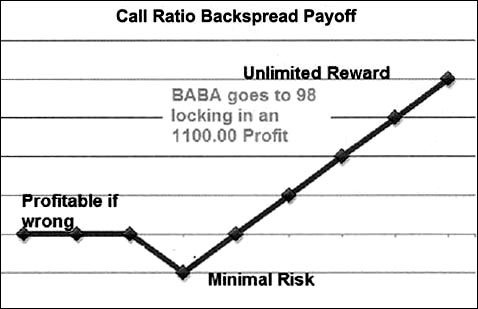
Long Ratio Backspreads
By: Todd Horwitz
The following is an excerpt from Todd "Bubba" Horwitz's Treasure Trove of Insider Secrets
Long Ratio Backspreads allow a trader to take an outright long or short position in the market without buying a put or call, outright. In some cases, the ratio will allow the trader to do a spread that will limit risk without limiting reward for a credit. The size of the contracts used and strike differential will determine if the spread can be done for a credit, or if it will be a debit. The closer the strike prices are the less market risk, but the greater the premium risk.
The Call Ratio Backspread is a bullish strategy. Expect the stock to make a large move higher. Purchase calls and sell fewer calls at a lower strike, usually in a ratio of 1 x 2 or 2 x 3. The lower strike short calls finance the purchase of the greater number of long calls and the position is usually entered into for no cost or a net credit. The stock has to make a large enough move for the gain in the long calls to overcome the loss in the short calls because the maximum loss is at the long strike at expiration. Because the stock needs to make a large move higher for the back-spread to make a profit, use as long a time to expiration as possible.
The Trade
The Trade: |
AliBaba |
Date Initiated: |
August 9, 2016 |
Options Used: |
CALLS |
Strikes: |
85/86 |
Credit Collected: |
.10 |
Max Risk: |
90.00 |
Max Reward: |
Unlimited |

The Exit
The Exit: |
Bullish BABA |
Sell 1 Contracts August 19th 85 CALL |
|
Buy 2 Contracts August 19th 86 CALLS |
|
Total for Trade: |
Credit of .10 |
Sell the 1 extra 86 CALL for 12.00 |
|
But there is more...
Rules for Trading Long Option Ratio Backspread
A long Backspread involves selling (short) at or in-the-money options and buying (long) a greater number of out-of-the-money options of the same type. The option that is sold should have higher implied volatility than the option bought. This is called volatility skew. The trade should be made with a credit. That is, the amount of money collected on the short options should be greater than the cost of the long options. These conditions are easiest to meet when volatility is low and strike price of the long option is near the stock price.
Risk is the difference in strikes X number of short options minus the credit. The risk is limited and maximum at the strike of the long options.
The trade itself is great in all trading environments, especially when trying to pick tops or bottoms in any stock, commodity or future.